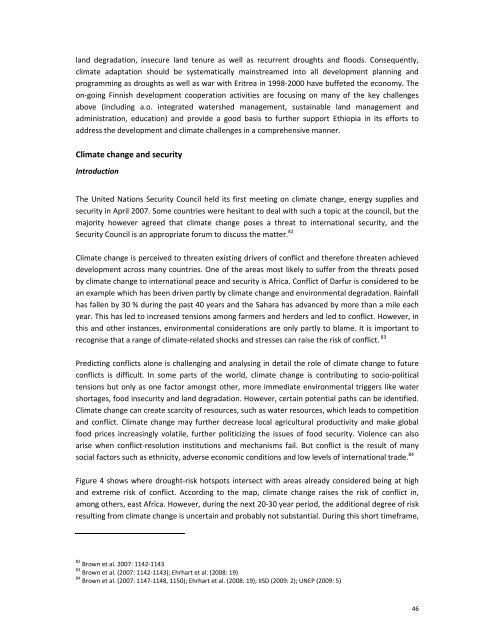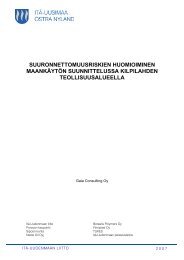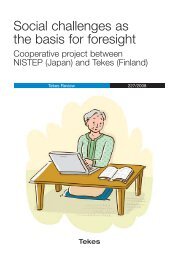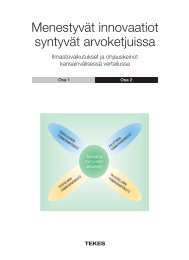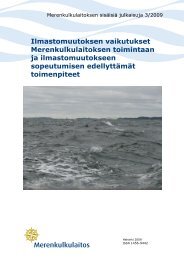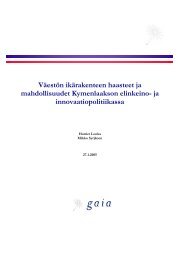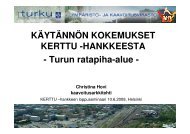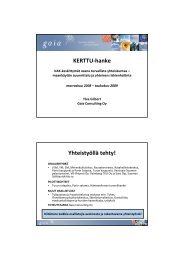Climate Risk Management in Finnish Development Cooperation - Gaia
Climate Risk Management in Finnish Development Cooperation - Gaia
Climate Risk Management in Finnish Development Cooperation - Gaia
You also want an ePaper? Increase the reach of your titles
YUMPU automatically turns print PDFs into web optimized ePapers that Google loves.
land degradation, <strong>in</strong>secure land tenure as well as recurrent droughts and floods. Consequently,<br />
climate adaptation should be systematically ma<strong>in</strong>streamed <strong>in</strong>to all development plann<strong>in</strong>g and<br />
programm<strong>in</strong>g as droughts as well as war with Eritrea <strong>in</strong> 1998-2000 have buffeted the economy. The<br />
on-go<strong>in</strong>g F<strong>in</strong>nish development cooperation activities are focus<strong>in</strong>g on many of the key challenges<br />
above (<strong>in</strong>clud<strong>in</strong>g a.o. <strong>in</strong>tegrated watershed management, susta<strong>in</strong>able land management and<br />
adm<strong>in</strong>istration, education) and provide a good basis to further support Ethiopia <strong>in</strong> its efforts to<br />
address the development and climate challenges <strong>in</strong> a comprehensive manner.<br />
<strong>Climate</strong> change and security<br />
Introduction<br />
The United Nations Security Council held its first meet<strong>in</strong>g on climate change, energy supplies and<br />
security <strong>in</strong> April 2007. Some countries were hesitant to deal with such a topic at the council, but the<br />
majority however agreed that climate change poses a threat to <strong>in</strong>ternational security, and the<br />
Security Council is an appropriate forum to discuss the matter. 82<br />
<strong>Climate</strong> change is perceived to threaten exist<strong>in</strong>g drivers of conflict and therefore threaten achieved<br />
development across many countries. One of the areas most likely to suffer from the threats posed<br />
by climate change to <strong>in</strong>ternational peace and security is Africa. Conflict of Darfur is considered to be<br />
an example which has been driven partly by climate change and environmental degradation. Ra<strong>in</strong>fall<br />
has fallen by 30 % dur<strong>in</strong>g the past 40 years and the Sahara has advanced by more than a mile each<br />
year. This has led to <strong>in</strong>creased tensions among farmers and herders and led to conflict. However, <strong>in</strong><br />
this and other <strong>in</strong>stances, environmental considerations are only partly to blame. It is important to<br />
recognise that a range of climate-related shocks and stresses can raise the risk of conflict. 83<br />
Predict<strong>in</strong>g conflicts alone is challeng<strong>in</strong>g and analys<strong>in</strong>g <strong>in</strong> detail the role of climate change to future<br />
conflicts is difficult. In some parts of the world, climate change is contribut<strong>in</strong>g to socio-political<br />
tensions but only as one factor amongst other, more immediate environmental triggers like water<br />
shortages, food <strong>in</strong>security and land degradation. However, certa<strong>in</strong> potential paths can be identified.<br />
<strong>Climate</strong> change can create scarcity of resources, such as water resources, which leads to competition<br />
and conflict. <strong>Climate</strong> change may further decrease local agricultural productivity and make global<br />
food prices <strong>in</strong>creas<strong>in</strong>gly volatile, further politiciz<strong>in</strong>g the issues of food security. Violence can also<br />
arise when conflict-resolution <strong>in</strong>stitutions and mechanisms fail. But conflict is the result of many<br />
social factors such as ethnicity, adverse economic conditions and low levels of <strong>in</strong>ternational trade. 84<br />
Figure 4 shows where drought-risk hotspots <strong>in</strong>tersect with areas already considered be<strong>in</strong>g at high<br />
and extreme risk of conflict. Accord<strong>in</strong>g to the map, climate change raises the risk of conflict <strong>in</strong>,<br />
among others, east Africa. However, dur<strong>in</strong>g the next 20-30 year period, the additional degree of risk<br />
result<strong>in</strong>g from climate change is uncerta<strong>in</strong> and probably not substantial. Dur<strong>in</strong>g this short timeframe,<br />
82 Brown et al. 2007: 1142-1143<br />
83 Brown et al. (2007: 1142-1143); Ehrhart et al. (2008: 19)<br />
84 Brown et al. (2007: 1147-1148, 1150); Ehrhart et al. (2008: 19); IISD (2009: 2); UNEP (2009: 5)<br />
46


